Who prayed Joan of Arc on May 30, 1431, when, in the flames of the stake, she was begging her god to welcome her into his kingdom? An emblematic story of pagan survivals, fairy trees and apparitions of angels of light. A fatal destiny, between predestinations to martyrdom, Apollonian ecstasies and heresies.
di Marco Maculotti
Cover: Jules Bastien-Lepage, Giovanna D'Arco, 1879
"It is a frightening thing to fall into the hands of the Living God!"
Robert W. Chambers, In the Dragon's Court (In The King in Yellow, 1895)
Swell many believe that, historically, Europe has been entirely Christian for almost a thousand years, the study of period testimonies, starting from witch trials and ecclesiastical canons, tells us a very different story, which emerges between the folds of who knows how to see it. For the scholars of the history of religions of the last century, on the other hand, the cultic and ideological contrast that opposed Christianity and native European religions for almost two millennia is well known, which has been analyzed by the writer on several occasions on pages of «AXIS world» [1], as well as previously by much more authoritative authors than myself [2].
In a 1974 British TV drama, Penda's Fen by David Rudkin and Alan Clarke [3], which at the time was broadcast in prime time on British television networks, at one point an Anglican pastor, father of the protagonist, takes the floor. The Church - he confesses to his son - has always fought within it a centuries-old war in which the two are opposed elemental forces of Light and those of Darkness. Still significantly, the reverend adds that he is not sure on which side the Holy Church has sided during all this time, remarking that "When the church, any church wages war against an older god, it must necessarily equate him with the devil", and bringing to his son the example of Giovanna D'Arco, of which he was said to practice the old religion, the "primitive religion of the fields and villages". About did the heroine pray - the curate wonders with yearning - when, amidst the flames of the stake, he implored his god to welcome her into his grace?
"The plaster Christ of the cathedrals or her old, elemental village god? The son of Adam, son of man. The torn, flayed hero, bleeding on the tree. The old man-god. Unchanging, ever changing. Samson, Marduk, Jesus, Balder, Heracles… By whom the world is haunted since the first beat of the heart of man. "

The story of Joan of Arc is truly emblematic in this regard. Born January 15, 1412 a Domremy, a village in Barrois, was burned at the stake on May 30, 1431, accused of idolatry, apostasy and heresy in front of a huge crowd in the square of Rouen. She was only 19.
And to say that, until a few months earlier, even the King of France Charles VII he paid all the highest honors to the Maid, to the point of authorizing the engraving of the royal coat of arms on her shield. His providential exploits of war within the dramatic framework of the Hundred Years War, carried out between 1428 and 29, in the siege of Orleans, in the Loire campaign, in the battle of Patay and in numerous others against the English they had literally placed it in the odor of sanctity. Why then, overnight, was she condemned to such a horrible end? Why did the king himself betray her, handing her over to the English, allowing her first imprisonment and then her martyrdom?
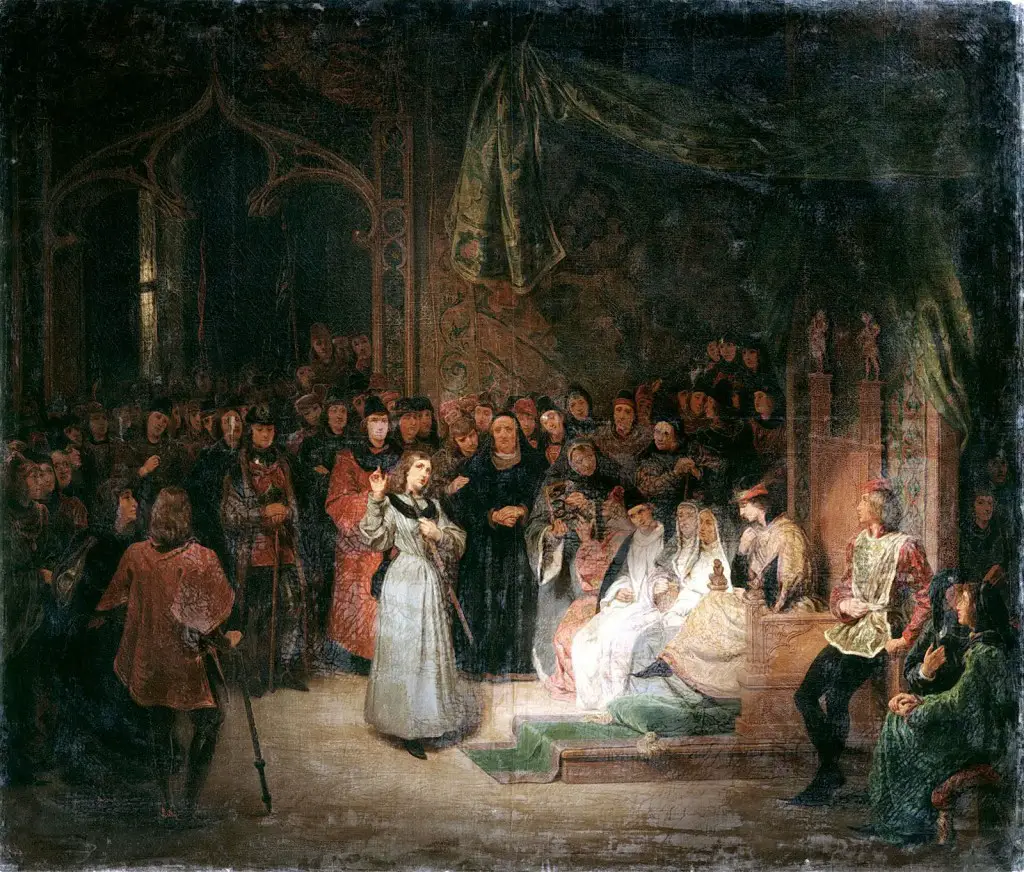
Giovanna d'Arco was born, as we have said, in Domrémy: this place was known in ancient times for being the birthplace of numerous psychics and healers, individuals to whom the so-called "second sight" is attributed in the Celtic tradition [4]. Not far from the village stood a beech tree, called by the commoners «The Tree of the Fairies» or «of the Ladies». It was a beech, from which every year, for the year-end party, the "May pole" (or, more simply, "May"). A short distance away stood a sacred spring, to whose waters the power to heal fevers was attributed. Giovanna danced around theArborum dominarum, wove wreaths of fresh flowers and decorated their branches in honor of the image of Santa Maria di Domrémy, and "sang songs and poems with certain invocations" [5]. It is evident that the mythical and sacred substratum of the place is anything but Christian: we are in the area of Fairy cult (Faes) or "Dame Bianche", with an unmistakably Celtic flavor [6]. That of fairy tree it is a tradition still widespread in Ireland today: I myself have visited a couple, at the sacred Hill of Tara and the corridor tomb of Carrowkeel, both sites dating back to the Neolithic (which speaks volumes about the historical longevity of certain cults).
It was inevitable that sooner or later even the ecclesiastical power would notice it, even more alarmed as there was a rumor among the commoners that Giovanna had received her divine mission from the Fairy Tree. Under her branches he had heard voices, which from that moment on directed her in all the most important decisions of her life. During the trial proceedings, questioned by the English, she confessed that her godmother had seen the fairies and talked to them, but stressed the fact that she was "a good woman, and not a diviner or a witch" [7]. The confessions of the young woman are reminiscent of those of the gods Benandanti Friulians when they were questioned by the Inquisition, between the sixteenth and eighteenth centuries, about their characteristic "ecstatic-agrarian" cults, with a clear pagan imprint [8]: like these, Giovanna also receives the visits of a "Angel of light", who will later discover to be San Michele.
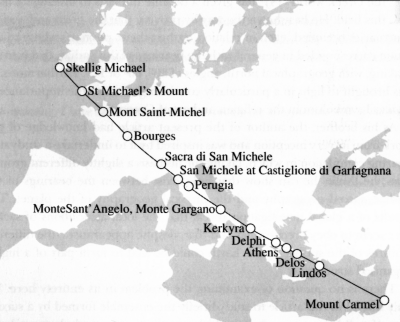
Do not deceive the Christian denomination: in all Celtic territories San Micheal traced the previous divine figure of Lugh / Belanu [9], to the point that in the same sacred sites ringed in the famous "Line of San Michele" in this geographical area (Skellig Michael in Ireland, St. Michel's Mount in England, Mont-Saint-Michel in Brittany and the Sacra di San Michele in Val di Susa, near Turin) should be seen primarily as sanctuaries of ancient god of light: "The old man-god, unchanging, ever changing… by whom the world is haunted since the first beat of the heart of man". The same Christian pilgrimage paths follow the ancient ones leylines which since time immemorial have linked sacred sites to each other: sources, caves, dolmens, menhirs and circles of megaliths [10]. Lugh was thought to be the most important of the gods Tuatha de Danann, divine entities of the Celtic tradition that in medieval times changed into fairies and do.
It is said incidentally that Turin is mysteriously marked, in local tradition, by the myth of the "fall of Phaeton", an episode that combines Apollonian aspects with others luciferians, and again that according to Diodorus Siculus (Bibliotheca historica, XNUMXst cent. A.D) Stonehenge he was nothing but a great one circular temple to Apollo Hyperborean, in which the god was honored by his druids priests (the Celtic counterparts of the Greek Iatromancers) and by the vestal saints [11]. And if the ancient proverb "nomen omen"Is worthy of fidelity, the surname with which Giovanna was born may not seem casual, the bow being traditionally sacred to the god Apollo, a fatal instrument, at the same time the bearer of death and mystical ecstasy, what the Greeks called μανία [12]. (Even the letter "J" in his signature closely resembles a taut arch). Not coincidentally, on the same sacred line as Lugh / San Michele there are also Delphi and Delos, sacred to Apollo.
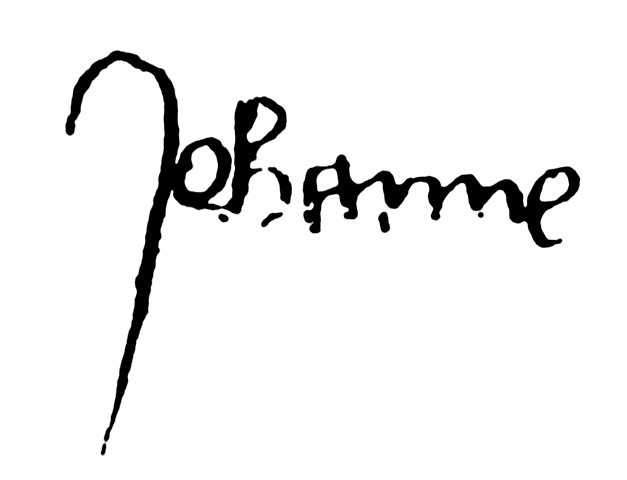
«QThose on my side know well that the voice was sent to me by God, they have seen and know this voice. My king and many others also heard the voices that came to me ... I saw him [Saint Michael] with the eyes of my body, as I see you» [13], Giovanna defended herself, claiming that she had seen him many times before knowing that it was San Michele, when she was still a child. By obeying the rumors, the Vestal news was convinced that she was doing the will of the "Holy People", of which St. Michael was the commander in the millenary war against Evil. She stubbornly refused to swear by the gospel and it was difficult to persuade her to do the same with her missal, and when asked if she had ever blasphemed God, she replied that she "never cursed the Saints." Asked if she had ever denied God, she stated that she "never denied the Saints": "I believe in Church that is on earth» [14].
Joan was very convinced of her divine mission, and no one could have convinced her otherwise. France, on the other hand, had been saved thanks to her, and to the voices she obeyed. At the beginning of the trial she said that she "she had come from God" and that she "she had nothing to do here", clamoring to be sent back as soon as she had come from. Like the Christian Savior, he already knew that his time was limited, because the voices of the Saints had revealed it to him: it would be taken "before the feast of St. John", that is, the summer solstice. However, they also told her that she should not grieve but fully accept her destiny and her mission, that she would eventually come to the kingdom of heaven. [15]. On these divine entities, which although in the proceedings of the process he calls "Angels" have multiple points of contact with the fairies (lit .: "the bright ones", "the shining ones") of Celtic folklore, he had said to his accusers: "They often come among men without anyone seeing them; I myself have seen them many times among people».
Joan of Arc was burned at the end of May, hoisted to a pole that appears somewhat ironically as an ineffable double symbolic of the "maypole" of Domremy, that beech tree where, at the age of 13, he heard the voices of the Holy Persons for the first time. The blazing flames also bring to mind i Beltane fires, emblem of death and rebirth. Later his ashes were collected and dispersed in water: a recurring funeral ritual in the bed of pre-Christian religions, European and non-European, which in some cases follows the ritual sacrifice of the incarnate god [16].
Right: François Chifflart, Joan of Arc at the stake, Nineteenth century
Note:
[1] cf. MACULOTTI, Imbolc, the triple goddess Brigit and the incubation of spring e From Pan to the Devil: the 'demonization' and the removal of ancient European cults, on AXISmundi.blog
[2] cf. ex multis GINZBURG, Night story. A decipherment of the Sabbath; CENTINI, WitchcraftLigurpress 2008; GALLI, Mysterious West. Bacchantes, Gnostics, witches: the losers of history and their legacy, Rizzoli, 1987; CHIAVARELLI, Diana, Harlequin and the flying spirits: from shamanism to the "wild hunt", Bulzoni 2007; SAINTIVEYS, The holy successors of the gods. The pagan origin of the cult of the saints, Arkeios 2016
[3] cf. MACULOTTI, “Penda's Fen”: the sacred daimon of ungovernable, on AXISmundi.blog
[3] cf. KIRK, The Secret Kingdom, Adelphi 1993
[5] cit. MURRAY, Witches in Western Europe, Tattilo 1974, p. 301
[6] cf. MACULOTTI, Marian & "Dame Bianche" appearances, on AXISmundi.blog
[7] cit. MURRAY, op. cit., p. 300
[8] cf. GINZBURG, The Benandanti. Witchcraft and agrarian cults between the sixteenth and seventeenth centuries, Einaudi 1966; MACULOTTI, The Friulian benandanti and the ancient European fertility cults, on AXISmundi.blog
[9] «Belanu probably means the equivalent of he who is bright: the luminous god. The very ancient root call present in many protolanguages, according to some sources it would have the transcendental meaning of appear from the other world and / or enlightenment from the world of the gods […] Subsequently stabilized in light"(Cit. Wikipedia, Belanu); cf. MACULOTTI, The festival of Lughnasadh / Lammas and the Celtic god Lugh, on AXISmundi.blog
[10] cf. MARKALE, Celtic Christianity and its popular survivals, Arkeios 2014; CHARPENTIER, The giants and the mystery of the origins, Editions The Age of Aquarius 2016
[11] Quoting Hecateus of Abdera, a XNUMXth century historian and "certain others", Diodorus writes that "in a land beyond the Celts [or Gaul] there is" an island no smaller than Sicily "in the north sea, called Hyperborea, because it lies beyond the place of origin of the north wind (Boreas). The inhabitants of this place venerate Apollo, there being "both a magnificent area sacred to Apollo and a remarkable temple which is adorned with numerous votive offerings and is circular in shape".
[12] cf. MACULOTTI, Apollo the Destroyer: “coincidentia oppositorum” in hyperborean mysticism and eschatology, on AXISmundi.blog
[13] cit. MURRAY, op. cit., p. 338
[14] cit. LEAF, The Book of Witches, Rusconi 1980, p. 69
[15] cit. MURRAY, op. cit., p. 341
[16] cf. FRAZER, The golden branch

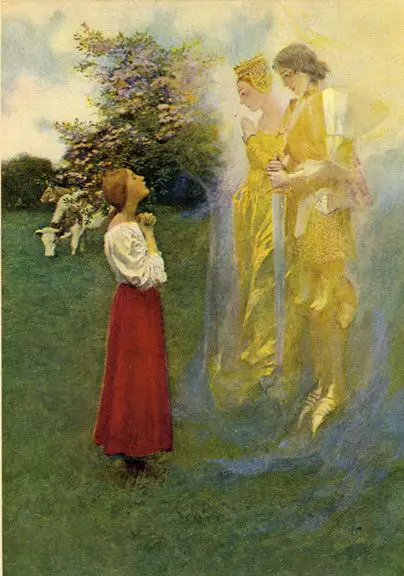
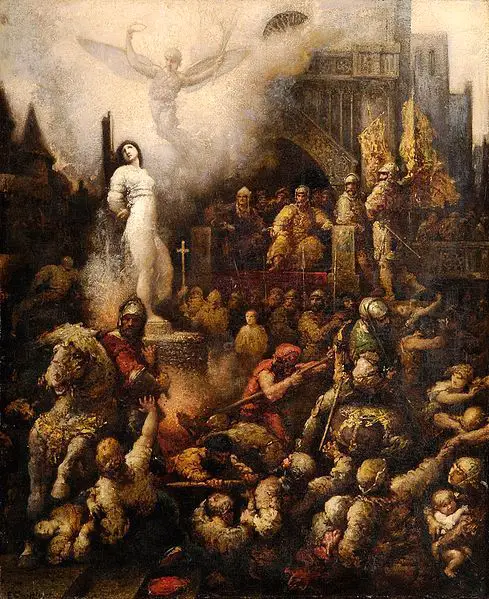
3 comments on “Joan of Arc, the Fairies and "San Michele""